
 |
|
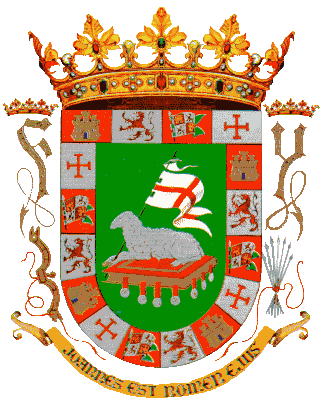













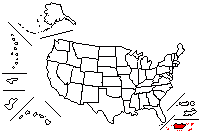
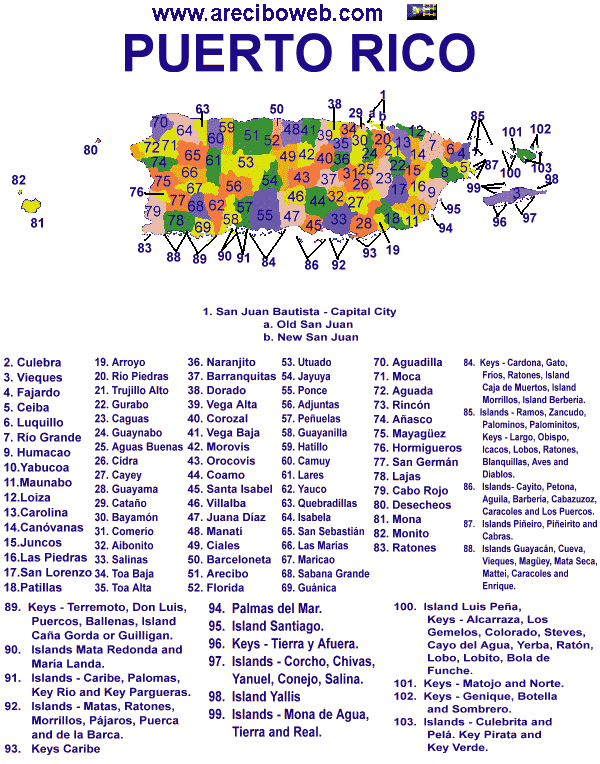

THE BORINQUEÑA
OH BEAUTIFUL BORINQUEN
THE LAND OF BORINQUEN
WHEN AT HER BEACHES COLUBUS ARRIVED, |
LA BORINQUEÑA
LA TIERRA DE BORINQUEN |

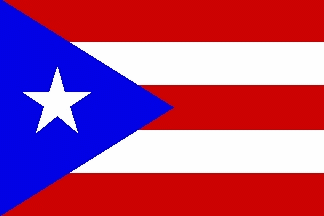
Flag:
Back in 1511, Spain issues an official flag for Puerto Rico, based in the Coat of Arms authorized by the spanish monarchs.
On December 22, 1895, a group of 59 Puerto Ricans gather at "Chimney Corner Hall" in New York City and organizes a political group, attached to the Cuban Revolutionary Party to organize the Pro-Independence movement in Puerto Rico, still under Spanish ruling. According to the meeting acts, the flag "...is same as the cuban, but the color stripes are inverted..."
There are different theories regarding the origins of our flag, one of them names Manuel Besosa as the designer , in a letter written by his daughter she says, "...my father asked me to sew together some pieces of cloth, white, red and blue that he brought himself , this tiny flag had 5 alterned stripes, red and white, and a triangle with a five point star within it...".
This is the symbolism according to the 1895 meeting:
There has been an issue during recent years regarding the blue tone of the triangle
in the Puerto Rican flag. The 1895 original design used a sky blue, however when the flag
was adopted officially by the Commonwealth in 1952 it featured a dark blue very similar
to that of the US flag. With the celebration of the flag's 100 aniversary in 1995
the current pro- statehood administration decided to go back to the original sky blue tone.
Still, there are many different tones of blue used around the island, even among
those in public buildings.
In 1995, during the pro-statehood government of Gov. Rossello', the royal or medium blue flag was made the official flag
of PR, replacing the Navy blue one. The Navy blue flag was adopted in 1953 by the Commonwealth government of Gov.
Muñoz Marín to match Old Glory as both flags were officially flown together for the first time since the USA occupation of 1898. It is ironic that a pro-statehood government chose the same flag that was previously ban for generations by both countries as a symbol of rebellion and independence. The sky-blue flag, has never been recognized as an official flag. But, it is true that it has been used recently by pro-independence sympathizers. It was made that way to make it as far likely as possible to the USA flag. Two very big flags has been posted at Vieques and Cayey.
The blue color of the Cuban flag was never intended to be sky-blue. It is not in the CoA. Neither it was to be Navy blue.
It is a medium to medium-dark blue. So, when people say that the PR flag was inspired by the Cuban flag, only the
colors reversed, they are really referring to the now official royal blue version, not the sky-blue flag..
.
Five equal horizontal bands of red (top and bottom) alternating with white; a blue isosceles triangle based on the hoist side bears a large white five-pointed star in the center; the design of the Puerto Rican flag was not based on the United States flag, but rather on the Cuban flag. It was designed in the 1890's by the Puerto Rican Section of the Cuban Revolutionary Party in solidarity with their cause. The colors were inverted.
Red Stripes - The blood from the brave warriors.
White Stripes - Victory and peace after obtaining indepence.
Blue Triangle - Our sky and coastal waters.
White Lone Star - Our beautiful Island.
It wasn't but until 1952 that our Legislature approved the final symbolism of our flag:
Red Stripes - stands for the "blood" that nourishes the three branches of our government; Legislative, Executive and Judiciary.
White Stripes - represents individual liberty and the rights that keeps in perfect balance our form of government.
Blue Triangle - stands for the "Republican Government", represented by the three branches.
White Lone Star - represents "The Commonwealth of Puerto Rico".
source
Victor Quinones, 24 March 2000
source
Blas Delgado Ortiz, 6 August 2001
source
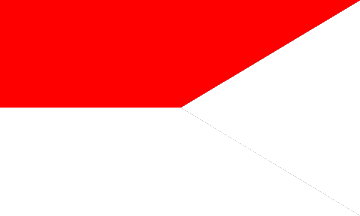
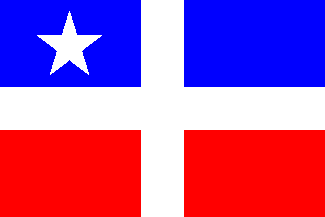
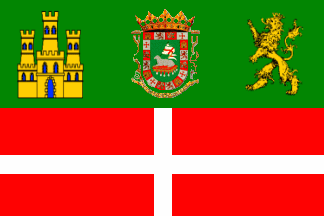
Bandera: En 1511, España consede
una bandera para Puerto Rico, basada en el escudo de armas,
autorizado por los monarcas españoles. En el 22 de diciembre de 1895,
al grupo de 59 puertorriqueños reunidos en el Chimney Corner Hall
en la ciudad de Nueva York y organiza un grupo político, unido al
partido revolucionario cubano para organizar el movimiento de
Pro-Independencia en Puerto Rico, estando aún bajo el dominio español.
De acuerdo a las actas de esa reunión, la bandera "... será igual que la bandera
cubana, pero con los colores invertidos... " Hay
diversas teorías con respecto a los orígenes de la bandera, uno
de ellos nombre a Manuel Besosa como el diseñador, en una carta escrita
para su hija él dice, "... mi padre
pidió que cosiera algunos pedazos tela, blanco, rojo y azul que él trajo
consigo, esta bandera minúscula
tenía 5 franjas alternadas, el rojo y el blanco, y el triángulo
con una estrella de cinco puntas en ella... ".
Este es el simbolismo de acuerdo
con la reunión del 1895:
Frajas rojas - la sangre de los valientes guerreros.
No fué sino hasta el 1952 que la legislatura de Puerto Rico aprovó el
simbolismo final de la Bandera:
Franjas rojas - es por la sangre que alimenta las tres ramas del gobierno
de Puerto Rico; Legislativo, Ejecutivo y Judicial.
Ha habido unas diferencias en los años recientes a consecuencia del el tono
del color azul del triangulo de la bandera de Puerto Rico. El diseño original
de 1895 utilizó azul real o cielo, sinembargo cuando la bandera fué
adoptada oficialmente por el gobierno en el 1952 fué cambiada a azul obscuro
o marino muy similar al azul utilizado en la bandera de los Estados Unidos.
Con la celebración de los 100 años de la bandera, en 1995 la administración de
ese entonces decidió volver al original azul cielo o real. Continuan habiendo
muchos diferentes tonos de azul utilizado en la isla, entre los edificios
públicos.
Victor Quiñones, 24 de marzo de 2000.
En el 1995, durante el govierno pro-estadidad del gobernador Rosselló, el
azul real o azul cielo fué hecho oficial para la bandera de Puerto Rico,
reemplazando el azul obscuro o marino. La bandera con el azul marino fué
adoptada en el 1953 por el gobierno del gobernador Muños Marín para que se
emparejara con la de los Estados Unidos que oficialmente fué enarbolada
junto a la bandera de los Estados Unidos por primera vez desde la ocupación
de este último en el 1998. Es irónico que un gobierno pro estadidad eligiera
la misma bandera que fué previamente prohibida por generaciones por ambos
países como un simbolo de rebelión e independencia. La bandera de azul claro,
nunca ha sido reconozido como bandera oficial, pero, es cierto que ha sido
utilizada por simpatizantes pro independencia. Esto fué hecho para hacerlo
lo más diferentes posible a la bandera de los Estados Unidos. Hay dos banderas
muy grande en Vieques y en Cayey. El color azul de la bandera de Cuba nunca
fué azul claro. No está en el escudo de armas de Cuba tampoco ni tampoco es
el azul marino. El color azul esta en un intermedio de azul obscuro y azul
claro. Entonces, cuando las personas dicen que la bandera de Puerto Rico
fué inspirada por la bandera de Cuba, solo invirtiendo los colores, ellos
realmente se refieren al ahora version oficial del azul real y no al azul
claro.
La segunda bandera que aparece arriba color rojo y blanco.
Es una Enseña de Registro Colonial de España Obsoleta.
La diferencia entre las provincias europeas y aquellos territorios de ultramar es que las
primeras eran banderas rectangulares, mientras que las últimas eran de dos puntas.
La tercera bandera es la que se conoce como La Bandera del Grito de Lares,
utilizada en 23 de septiembre de 1868 durante una no exitosa revelión
contra el gobierno español. La bandra sigue preservada en la Universidad
de Puerto Rico.
Sobre la tercera bandera: En el 1511, España consede a la isla una bandera
basada en el escudo de armas y que fué conferida por los reyes. Esta bandera
fué la más hermosa y antigua de toda America: "un campo rojo cun una cruz
blanca en el centro en partes iguales dos a dos en el inferior y en la mitad
superior con un campo o fondo verde el escudo de armas de Puerto Rico, un Castillo
a la izquierda y un Leób a la derecha de la misma, en representación de
Castilla y León, el catillo y el león son en amarillo oro sobre un fondo
verde..."
Cinco franjas horizontales iguales donde se alternar el rojo
con blanco; un triángulo isósceles azul en lado donde se iza la bandera.
Lleva una estrella de cinco puntas blanca grande en el
centro; el diseño de la bandera de Puerto Rico no fue basado en la
bandera de Estados Unidos, sino algo en la bandera cubana. Fué
diseñado en el 1890's por la sección de puertorriqueños del partido
revolucionario cubano en solidaridad con su causa. Los colores fueron
invertidos.
Frajas blancas - la victoria y la paz después de obtener la independencia
Triangulo azul- nuestro cielos y aguas costeras.
Estrella blanca - nuestra isla.
Franjas blancas - representa la libertad individual y los derechos adquiridos
en perfecto balance en la forma de gobierno.
Triangulo Azul - representa la forma de gobierno republicana que se unen y
que es representada por las 3 ramas.
Estrella Blanca - representa a Puerto Rico.
fuente
Blas Delgado Ortiz, 6 August 2001
fuente
fuente
fuente
source
Los escudos de armas (coat of arms) se componen de hasta cinco partes a saber: el blasón (shield), la cresta, usualmente un casco con cresta (helmet with a crest), o una corona mural (mural crown) en el caso de los países iberoamericanos, los soportantes (supporters), el mantelete o lambrequín (mantling) y el pergamino con leyenda (scroll with mottoes). La parte más importante y distintiva lo es el blasón, que describe o identifica al portador, en este caso al país. Así las cosas, una bandera heráldica o BOA (banner on arms) es una representación del blasón y sólo debe poseer los emblemas o elementos presentes en éste, sin incluir las demás partes del escudo. En el caso del escudo de Puerto Rico, el blasón posee además una bordura con elementos representativos y presentes en el estandarte de Castilla y León del siglo XVI. El castillo, el león, la bandera de Castilla-Aragón y la Cruz de Jerusalén son elementos recurrentes en muchos escudos españoles. Si la supuesta bandera de PR era tal cual descrita y según te la dibujé, no es heráldica, porque: 1- No representa los elementos distintivos del blasón (el cordero pascual y el Libro del Apocalipsis o Revelaciones) 2- El escudo no está dividido "per fess" (en dos mitades horizontales iguales) verde y rojo como en la bandera, sino que es de fondo verde solamente. La bandera debió de ser entonces completamente verde. 3- El castillo, el león y la cruz en la bandera no son elementos del escudo que representan a PR, sino elementos bordurales que representan a Castilla y León en vez. 4- Si la cruz blanca comprendiera toda la mitad inferior roja, entonces esta parte sería una representación cromal (color) invertida de la bandera del cordero pascual (cruz roja sobre fondo blanco). Pero la bandera representa al Cristianismo e identifica al cordero como el Pascual (Jesús) y no a PR en sí. Aunque esta bandera hubiere existido verdaderamente, no puede ser considerada heráldica. Tendrá elementos heráldicos, pero eso no la hace una como tal. También, no pudo ser conferida por Fernando el Católico. Quizás fue conferida por otro Rey varios siglos más tarde. Existió la Cédula de Gracia de 1815 dada por el Rey Carlos V. ¿Quién sabe si en esta cédula se confirió esta bandera? Demás está decir que no conozco ninguna bandera dada a alguna colonia española por cualquier rey español. ¿Pudo haber sido esta bandera conferida en vez a Ponce de León como gobernante o a algún otro gobernante posterior. Se sabe que tanto él como su hijo y Diego Colón (hijo del Almirante) se les confirió un blasón o escudo distintivo a sus familias.

Puerto Rico (Port Rich)
Capital City: San Juan Bautista (Saint John Babtist)
Constitution: July 25, 1952 Commonwealth of Puerto Rico named in Puerto Rico as
Estado Libre Asociado de Puerto Rico (Free State and Asociate of Puerto Rico)
Motto: "Joannes Est Nomen Ejus" Juan (John) is it name.
The original name of the island was San Juan Bautista and the original
name of the Capital City was Puerto Rico, but some error in Spain changed the name and named the Island as Puerto Rico
and his Capital City as San Juan Bautista.
National: Puertorricans, Boricua, Boricuans, Borincano.
Nickname: The Enchanted Isles, The Shining Star of Caribbean, Caribbean's Pearl
Origin of state's name: Named by spanish in honor of Saint John Babtist, but later was change by
error from Spain to Puerto Rico (Port Rich). Puerto Rico comes for all the gold there
was in the Island.
Puerto Rico
Ciudad Capital: San Juan Bautista
Constitución: 25 de julio de 1952, Estado Libre Asociado de Puerto Rico en inglés se lee
Commonwealth of Puerto Rico y no como Free stated and asociate of Puerto Rico.
Lema:"Joannes Est Nomen Ejus" Juan es su nombre
El nombre original de la isla era San Juan Bautista y de su capital
era Puerto Rico, pero por un error en España los nombre fueron invertidos y por eso a la isla se le conoce como
Puerto Rico y a la capital como San Juan Bautista.
Gentilicio: Puertorriqueño, Boricua, Borinqueño, Borincano.
Cognomento: La Isla del Encanto, La Estrella reluciente del Caribe, Perla del Caribe.
Origen del nombre: Fué dado por los Españoles en honor de San Juan Bautista, pero después fué cambiado por error en España
a Puerto Rico. El nombre de Puerto Rico es por todas las riquezas y oro encontrada en la isla.


Our Coat of Arms uses symbols of our history, culture and religion. It was first recognized by the Spanish Crown in 1511, but it wasn't until March 9,1905 that al law, establishing the official Coat of Arms was signed. After numerous investigations and amendments to that statute, the final version was approved and signed into law in 1976.
The green background stands for our vegetation, our hopes and courtesy. Within the background there's a lamb on top of the Book of Revelations, holding the seven seals of The Apocalypse. The lamb symbolizes peace, purity, humble, integrity, and holds a white flag with a red cross. The flag means "truce", or knowledge to stop fighting. Both, the lamb and the flag, are symbols of "John The Baptist" or San Juan Bautista, the original name given by the Spanish settlers.
rim is covered by 16 symbols: castles signifying the "Kingdom of Castilla" and lions, representing the "Kingdom of Leon" and a flag, with both, lions and castles, representing the unity of both kingdoms, also shows the "Cross of Jerusalem" used by the Monarchs to expel the "non christians" from the Spanish peninsula. The crown on top symbolizes the "Royalty" who authorized this shield. To the right, an "F" for Fernando, to the left, a "" for Ysabel, the King and Queen of the Spanish Empire. The motto reads: "Joannes Est Nomem Ejus", it means "John is it name", the original name of the island.
Coat of Arms is the oldest in use in America, other countries created a new Coat when they became independent, ours is the only one that remembers the Spanish presence in the "New World" or America.
source
El escudo de Puerto Rico lleva los símbolos de nuestra historia, cultura y religión. Fue otorgado por la Corona Española en el 1511, pero no fue hasta el 9 de marzo de 1905 que se aprueba la ley que establece el primer escudo de armas. Luego de varias investigaciones y enmiendas a la ley para obtener la interpretación del escudo, en el 1976 se aprueba el mismo como lo conocemos hoy.
El escudo se divide en tres (3) partes: jefe o parte superior, centro y punta o parte inferior. El color verde nos enmarca como isla pero a su vez puede representar las virtudes, la esperanza y la cortesía. En su interior se encuentra un cordero sobre el libro de los siete (7) sellos del Apocalipsis. El cordero plateado simboliza la humildad, pureza, integridad y paz y sostiene una bandera blanca con una cruz roja. La bandera siginifica tregua o el entendimiento para cesar la lucha. El cordero junto con la bandera son símbolo de San Juan Bautista, nombre que originalmente se le dio a la Isla.
El borde del escudo se compone de 16 piezas: castillos que representan el Reino de Castilla, leones por el Reino de León y una bandera de castillos y leones en representación de ambos reinos unidos y la cruz de Jerusalén usada por los reyes para expulsar a los moros de la Península. Sobre el jefe se encuentra una corona que simboliza la realeza de quienes otorgan el escudo. En la parte derecha aparece la inicial "F" de Fernando el Católico y a la izquierda "Y" de Ysabel, los Reyes de España. En la punta se encuentra inscrito en latín el lema "Joannes Est Nomen Ejus" que en español quiere decir "Juan es su nombre".
El Escudo Oficial de Puerto Rico, que simboliza nuestro nacimiento como pueblo, es el más antiguo de toda América pues las otras colonias hicieron nuevos emblemas al lograr su independencia. Es por esto que nuestro escudo es el único que recuerda la presencia de España en el Nuevo Mundo.
fuente

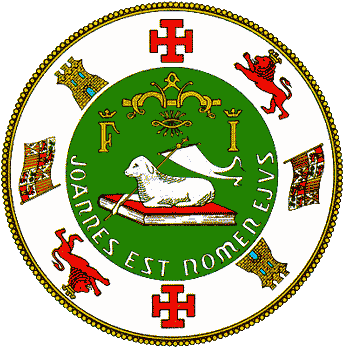
Puertorican's seal
Its rigorous heráldico symbolism, we can interpret it this
way: in the green center it appears a lamb that is used to represent
the peace and confraternity. On the lamb there is beam of
arrows that represent the creative force. Above it appears a yoke that represents
the union and harmony of efforts for great profits. Letters F and I,
initials of Fernando and Isabel, Kings from Spain when being
discovered Puerto Rico, evoke their great pioneering effort. The
inscription says: "Joannes Est Nomem Ejus"
Juan (john) is his name, because Puerto Rico was called
Island of San Juan Baptist originally . In the white edge towers
appear of Castile, lions of Leon, potenzadas crossings of Jerusalem
and Spanish flags that evoke the old Hispanic cultural roots of Puerto
Rico and form frame to the central symbols of the seal.
The figures that appear in the seal of
Puerto Rico are inspired by which appears in the coat of arms that Spanish
granted to Puerto Rico, at the beginning of century XVI.
Sello de Puerto Rico
Las figuras que aparecen en el Sello de Puerto Rico son
inspiradas en las que figuran en el escudo que la Corona Española otorgó a Puerto Rico,
a principios del siglo XVI.
Aparte su riguroso simbolismo heráldico, podemos interpretarlo de este modo:
en el centro verde aparece un cordero que se usa para representar la paz y confraternidad.
Sobre el cordero hay un haz de flechas simbó1ico de la fuerza creadora.
Más arriba aparece un yugo que representa la unión y armonía de esfuerzos para grandes logros.
Las letras F e I, iniciales de Fernando e Isabel,
Reyes de España al descubrirse Puerto Rico,
evocan su gran esfuerzo pionero. La inscripción reza: "Joannes Est Nomem Ejus" Juan es su nombre,
pues Puerto Rico se llamó originalmente Isla de San Juan Bautista. En el borde
blanco aparecen torres de Castilla, leones de León, cruces potenzadas de Jerusalén
y banderas españolas que nos evocan las antiguas raíces culturales hispánicas de
Puerto Rico y forman marco a los símbolos centrales del Sello.

History
The island of Puerto Rico is a self-governing territory of the United States
located on the northern margin of the Caribbean Sea, east of the Dominican Republic and
west of the Virgin Islands. It is bordered on the north by the Atlantic Ocean and on
the south by the Caribbean Sea. Approximately three times longer east to west than
north to south (192 km/119 mi long by 63 km/39 mi wide), it has an area of 9,085 sq./km. (
3,508 sq./mi. ). Visited by Christopher Columbus in 1493, during his second voyage,
Puerto Rico remained a Spanish colony until 1898,
when it was ceded to the United States by Spain as a result of the Spanish-American
War. Since 1952 the island has been officially known as the Commonwealth of Puerto Rico.
Spanish and English are official languages. San Juan is Puerto Rico's capital and largest city.
Puerto Rico has 78 municipalities**, or political units. The smallest municipio in area
is Catano, and the largest is Arecibo. The most populous is San Juan;
the least populous is the island-municipio of Culebra. Puerto Rico has five
metropolitan areas: San Juan, Caguas, Ponce, Mayaguez, Arecibo, and Aguadilla.
The consolidated metropolitan area of San Juan and Caguas has nearly 2 million people.
An overwhelming majority of the population are Christian, mostly Roman Catholic.
Puerto Rico's Hispanic history goes back to Columbus's arrival in 1493. Historical
sites of interest include old San Juan, which is rich in old Spanish architecture
and has narrow cobblestone streets and a pleasant Old World atmosphere. Among the
more outstanding buildings are the San Felipe del Morro and the San Cristobal fortresses,
the San Jose Church, and the Governor's Mansion. Some historical San Juan museums are
the Arsenal de la Marina, Museo de Casa Blanca, San Geronimo Fortress, El Morro Fortress,
the Palacio Santa Catalina (Governor's Mansion), and the Museo Pablo Casals, with mementos
of the famed Spanish cellist who organized a now world famous music festival in Puerto Rico.
Other museums include the Art and Anthropology Museum at the University of Puerto Rico,
in Rio Piedras; the Museum of Religious Art in the Porta Coeli Chapel in San German;
and the Museum of Art in Ponce. Archaeological museums of Indian artifacts in San Juan,
Caguana, and Utuado (at the Indian Ceremonial Ball Park) offer evidence of Puerto Rico's
pre-Columbian heritage.
Originally named Boriquen by the Taino Indians, Puerto Rico was settled by several
Indian groups long before it was visited (1493) by Christopher Columbus on
his second voyage to the New World and renamed San Juan Bautista. It was given
its present name, meaning "Rich Port," by Juan Ponce de Leon*, who established a
settlement inland from San Juan at Caparra in 1508. Although the dominant Taino
then numbered about 30,000, the Indian population, decimated by forced labor and
losses from rebellion, had virtually disappeared by 1582.
Spain, which had granted Puerto Rico almost complete autonomy by 1897,
ceded the colony to the United States in 1898 after the Spanish-American War**;
it was under U.S. military rule from 1898 to 1900. The first U.S. population census
of the island, taken in 1899, found that Puerto Rico had nearly a million people.
The governor and legislature were federally appointed until 1917, when the Jones
Act made all Puerto Ricans U.S. citizens and created an elected senate. Puerto
Rico did not elect its own governor until 1948. The commonwealth was established in 1952.
In 1948, Luis Munoz Marin***, Puerto Rico's first popularly elected governor,
initiated "Operation Bootstrap" to improve the economy.
Puerto Rico is governed by the Constitution of the Commonwealth of Puerto Rico,
approved by the U.S. Congress and ratified by the people in 1952. Puerto Ricans have
been U.S. citizens since 1917 and can vote in presidential elections while living in
the United States but not in Puerto Rico. Since 1980 they can participate locally
in presidential primaries. Puerto Ricans do not pay federal income taxes.
Modeled after that of the United States, the government of Puerto Rico has
three main branches--the executive, legislative, and judiciary.
All elected officials--the governor, resident commissioner in the U.S. Congress
(who has only committee voting privileges), senators, representatives, mayors,
and members of the local assemblies--serve 4-year terms and stand for election
on the same day as national elections are held in the United States.
The legislature is bicameral, with a Senate and a House of Representatives.
Local government is represented through the 78 municipios. Each municipio
has an urban seat with the same name and a series of smaller units called barrios.
A mayor and political assembly is elected every four years in each municipio.
Barrios are the smallest political unit and were originally mostly rural in nature.
Over time many have become urban barrios or wards. The judicial branch includes a
supreme court with 7 judges as well as an intermediate appellate court,
superior courts, and municipal courts. Under judicial reform, district
judgeships are being phased out as sitting judges retire or die.
Cases can be appealed to Puerto Rico's Supreme Court and eventually to the U.S.
Supreme Court. Violations of U.S. federal laws are considered directly at the U.S.
federal court level.
Traditionally, three major political parties have existed,
each representing one of the three political alternatives with regard to
association with the United States. The New Progressive party is a proponent of the U.S.
statehood option, the Popular Democratic party supports a continued commonwealth status,
and the Puerto Rican Independence party supports political independence.
The first two are majority parties while the latter is a minority party.
The Popular Democratic party has been in power for most of the years since 1940,
Luis Muñoz Marín was governor of Puerto Rico since 1948 to 1962 and Roberto Sanchez Vilella
was governor since 1962 to 1968, both of them by the Popular Democratic Party
although it was defeated in elections of 1968 by the New Progresive Party
with Luis A. Ferré**** as governor, in 1976 and 1980 with Carlos Romero Barceló.
In the elections of 1972,1984 and 1988
won the Popular Democratic Party with Rafael Hernández Colón as governor.
The New Progressive party won the governorship and legislative majorities in the
election of 1992 with Pedro Roselló González******** as governor and in January 1993,
a law was enacted making both Spanish
and English official languages. Later in 1993 the long-standing issue regarding
Puerto Rico's political status was again considered when a plebiscite was held
in which Puerto Rican voters could choose statehood, the commonwealth status in
place since 1952, or independence. By a narrow margin the voters opted to maintain
the commonwealth. The New Progressive party retained power in the elections of
1996 with a gubernatorial victory and legislative majorities in both houses. In the
election of 2000 won the Popular Democratic Party.
*First Governor of Puerto Rico named by Spain.
**See: municipalities of Puerto Rico (spanish)
***The Spanish-American War (1898) marked the emergence of the United States as a great
power.
****Jose Luis Alberto Muñoz Marín,On 1948 he
founded the Popular Demogratic Party. He was the first Puerto Rican governor chosen by
Puerto Rico. Although first he supported the independence for Puerto Rico
decided on the " Commonwealth " (Free State and Asociate)
like more economically viable.
*****Luis Alberto Ferré -, governor of Puerto Rico (1969-73). On 1967 he
founded the New Progresive Party; He was candidate in the 1968
and won the elections, breaking the dominion of the Popular Demogratic Party
by 28 years. He was senator in the 1976-1985.
Historia
Puerto Rico es un territorio autónomo de los Estados
Unidos situados en el margen norteño del Caribe, está al este de la
República Dominicana y al oeste de las islas Virgenes. Es
bordeado al norte por el Océano Atlántico y en el sur por el mar
Caribe. Visitado por
Cristobal Colón en 1493, durante su segundo viaje, Puerto Rico
seguía como colonia española 1898, cuando fué cedido por España a los
Estados Unidos como resultado de la guerra Hispano-Americana*.
Desde 1952 la isla se le conoce oficialmente como
Commonwealth of Puerto Rico (En Puerto Rico se le comoce como
Estado Libre Asociado). El Español y el
inglés son los idiomas oficiales. San Juan Bautista es
la Capital de Puerto Rico y
la ciudad más grande.
Puerto Rico tiene 78 municipios**, o unidades políticas. El municipio
más pequeño del área es Cataño, y el más grande es Arecibo. El
más poblado es San Juan; el menos poblado es la
isla-municipio de Culebra. Puerto Rico tiene cinco áreas
metropolitanas: San Juan, Caguas, Ponce, Mayagüez, Arecibo, y
Aguadilla. El área metropolitana consolidada de San Juan y Caguas
tiene casi 2 millones de personas de. Una mayoría abrumadora de la
población es cristiano, sobre todo católico.
La historia hispánica de Puerto Rico nos lleva hasta la llegada de
Cristobal Colón en 1493. Los sitios históricos del interés incluyen
Viejo
San Juan, que es rico en vieja arquitectura española y tiene calles
estrechas de ladrillos y una agradable atmósfera del viejo mundo.
Entre los edificios más excepcionales están las fortalezas San Felipe
del
Morro y San Cristobal, la iglesia del San Jose, y
la mansión del gobernador conocido como la Fortaleza o el Palacio de
Santa Catalina. Algunos museos históricos de San Juan
son el arsenal de la Marina, Museo de Casa Blanca, fortaleza del San
Geronimo, fortaleza del EL Morro, el Palacio Santa Catalina (mansión
del gobernador), y el Museo Pablo Casals. Otros museos incluyen el museo del arte y
de la antropología en la universidad de Puerto Rico, en Río Piedras;
el museo del arte religioso en la capilla de Porta Coeli de San Germán;
y el museo del arte en Ponce. Museos arqueológicos de
artefactos indios de San Juan, de Caguana,
y de Utuado (en el Parque ceremonial Indio) es la evidencia india de la
herencia de pre-Columbiana de Puerto Rico.
A varios grupos indios se ubicaron en Boriquen, nombre original
indigena de los Taínos para de
Puerto Rico, mucho antes de que fuera visitado (1493) por
Cristobal Colón en su segundo viaje al mundo nuevo y lo llamó
San Juan Bautista. Le fué dado su actual nombre por Juan Ponce de
Leon*, que estableció un
campamento interior de San Juan en Caparra en 1508. Aunque el
Taino para ese entonces eran cerca de 30.000, la población
india, diezmada por el trabajo forzados y las pérdidas de la
rebelión, habían desaparecido virtualmente por 1582.
España, que había concedido la autonomía casi completa de Puerto
Rico antes de 1897, cedió a la colonia a los Estados Unidos en 1898
después de la guerra Hispano-Americana** y estubo bajo régimen
militar de ESTADOS UNIDOS desde 1898 a 1900. El
primer censo de la población de ESTADOS UNIDOS de la isla, tomado en
1899, encontrada que Puerto Rico tenía cerca de un millón de personas.
El gobernador y la legislatura fué designada por los Estados Unidos
hasta el 1917 cuando la ley Jones concedió la ciudadanía americana a todos
los puertorriqueños y creó un senado electo por el pueblo.
Puerto Rico no eligió a su propio
gobernador hasta 1948. El "commonwealth" fue establecida en 1952 y se le
llamó en Puerto Rico como Estado Libre Asociado. En
1948, Luis Munoz Marin ***, pirmer gobernador puertorriqueño electo por puertorriqueños,
inició la operación manos a la obra para
mejorar la economía.
Puerto Rico es gobernado por la constitución del "Commonwealth" de
Puerto Rico (Estado Libre Asociado),
aprobado por el congreso de ESTADOS UNIDOS y ratificado
por el pueblo en 1952. Los puertorriqueños han sido ciudadanos de ESTADOS
UNIDOS desde 1917 y puede votar en elecciones presidenciales mientras
que vivan en los Estados Unidos pero no en Puerto Rico. Desde el año
1980 pueden participar localmente en primarias presidenciales. Los puertorriqueños
no paga impuestos federales. Tomando el modelo de Los Estados Unidos
, el gobierno de Puerto Rico tiene tres ramas
principales -- el ejecutivo, legislativo, y judicatura. Todos los
funcionarios elegidos -- el gobernador, el comicionado residente en el
congreso de ESTADOS UNIDOS (quién tiene solamente privilegios de la
votación del comité), los senadores, los representantes, los
alcaldes, y los miembros de las asambleas locales -- sirven términos
de cuatro años y celebran las elecciones el mismo
día que las elecciones nacionales se llevan a cabo en los
Estados Unidos. La legislatura es bicameral, con un senado y una
cámara de representantes. El gobierno local se representa con los 78
municipios. Cada municipio tiene un asiento urbano (capital del municipio)
con el mismo
nombre y una serie de unidades más pequeñas llamadas los barrios.
Eligen a un alcalde y a una asamblea política cada cuatro años en
cada municipio. Barrios es la unidad política más pequeña y era
originalmente sobre todo rural en naturaleza. Con el tiempo algunos barrios
se han convertidos en barrios urbanos. El rama judicial
incluye un Tribunal Supremo con 7 jueces tan bien como una corte de
apelación intermedia, cortes superiores, y cortes municipales. Bajo
reforma judicial, los jueces están en su posición
mientras se retiren o mueran. Los casos
se pueden abrogar al Tribunal Supremo de Puerto Rico y eventual a los
E.E.U.U.. Tribunal Supremo. Las violaciones de los leyes federales
de ESTADOS UNIDOS se consideran directamente en los E.E.U.U.. nivel
de la corte federal. Tradicionalmente, tres partidos políticos
importantes han existido, cada uno que representaba uno de los tres
alternativas políticos con respecto a la asociación con los Estados
Unidos. El Partido Nuevo Progresista es un propulsor a la unión permanente con los
E.E.U.U. bajo la
opción del Estadidad, el Partido Popular Demogrático apoya la continuación
del "Commonwealth" (Estado Libre Asociado), y el Partido Independentista Puertorriqueño
apoya independencia política. Los primeros dos son
partidos de la mayoría mientras que el último es un partido de la
minoría. El PPD ha estado en el poder
por la mayoría de los años desde 1940, Luis Muñoz Marín fué
gobernador de Puerto Rico desde 1948 a 1962 y Roberto Sanchez Vilella
fué gobernador desde 1962 a 1968, ambos por el PPD
aunque fué derrotado en elecciones de 1968 por el PNP con Luis A.
Ferré**** como gobernador, en 1976 y el
año 1980 con Carlos Romero Barceló. En las elecciones de 1972, 1984 y
1988 ganó el PPD con Rafael Hernández
Colón como gobernador.
El Partido Nuevo Progresista ganó la gobernación y las mayoría
legislativa en la elección de 1992 con Pedro Roselló
González como gobernador y en enero de 1993, formalizó con una ley
decretando como idiomas oficiales el español y el inglés.
Más tarde en 1993 la situación de muchos años con respecto al
estado político de Puerto Rico fué considerada otra vez cuando un
plebiscito fué llevado a cabo en el cual los votantes de Puerto Rico
podrían elegir la Estadidad, el actual "commonwealth" (Estado Libre Asociado
o la independencia. Por un margen estrecho los votantes optaron
mantener el "Commonwealth". El Partido Nuevo Progresista ganó
en las elecciones de 1996 con una victoria gubernamental y una
mayoría legislativa en ambas cámaras. En la elección de 2000 ganó
el partido democrático popular.
*Primer Gobernador de Puerto Rico nombrado por España.
**Ver: Municipios de Puerto Rico
***La guerra hispanoamericana (1898) marcó la aparición de los Estados
Unidos como potencia mundial.
****José Luis Alberto Muñoz Marín, Primer gobernador puertorriqueño elegido
por Puerto Rico. Aunque al principio apoyaba la independencia de Puerto Rico
optó por el "commonwealth" (Estado Libre Asociado) como el más económicamente
viable.
*****Luis Alberto Ferré -, gobernador de Puerto Rico (1969-73).
En 1967 fundó el Partido Nuevo Progresista; el fué su candidato en el
1968 ganando las elecciones, rompiendo el dominio del Partido Popular
Demogrático por 28 años. Fué senador en el 1976-1985.
